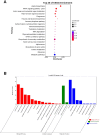Meta-QTL mapping for wheat thousand kernel weight
- PMID: 39737382
- PMCID: PMC11682887
- DOI: 10.3389/fpls.2024.1499055
Meta-QTL mapping for wheat thousand kernel weight
Abstract
Wheat domestication and subsequent genetic improvement have yielded cultivated species with larger seeds compared to wild ancestors. Increasing thousand kernel weight (TKW) remains a crucial goal in many wheat breeding programs. To identify genomic regions influencing TKW across diverse genetic populations, we performed a comprehensive meta-analysis of quantitative trait loci (MQTL), integrating 993 initial QTL from 120 independent mapping studies over recent decades. We refined 242 loci into 66 MQTL, with an average confidence interval (CI) 3.06 times smaller than that of the original QTL. In these 66 MQTL regions, a total of 4,913 candidate genes related to TKW were identified, involved in ubiquitination, phytohormones, G-proteins, photosynthesis, and microRNAs. Expression analysis of the candidate genes showed that 95 were specific to grain and might potentially affect TKW at different seed development stages. These findings enhance our understanding of the genetic factors associated with TKW in wheat, providing reliable MQTL and potential candidate genes for genetic improvement of this trait.
Keywords: QTL mapping; genetic populations; meta-analysis; thousand kernel weight; wheat.
Copyright © 2024 Tan, Guo, Dong, Li, Chen, Cheng, Pu, Yuan and Wang.
Conflict of interest statement
The authors declare that the research was conducted in the absence of any commercial or financial relationships that could be construed as a potential conflict of interest.
Figures






Similar articles
-
Considering causal genes in the genetic dissection of kernel traits in common wheat.J Appl Genet. 2016 Nov;57(4):467-476. doi: 10.1007/s13353-016-0349-2. Epub 2016 Apr 23. J Appl Genet. 2016. PMID: 27108336
-
Unravelling consensus genomic regions associated with quality traits in wheat using meta-analysis of quantitative trait loci.Planta. 2022 May 5;255(6):115. doi: 10.1007/s00425-022-03904-4. Planta. 2022. PMID: 35508739
-
Large-scale integration of meta-QTL and genome-wide association study discovers the genomic regions and candidate genes for yield and yield-related traits in bread wheat.Theor Appl Genet. 2021 Sep;134(9):3083-3109. doi: 10.1007/s00122-021-03881-4. Epub 2021 Jun 17. Theor Appl Genet. 2021. PMID: 34142166
-
Quick mapping and characterization of a co-located kernel length and thousand-kernel weight-related QTL in wheat.Theor Appl Genet. 2022 Aug;135(8):2849-2860. doi: 10.1007/s00122-022-04154-4. Epub 2022 Jul 8. Theor Appl Genet. 2022. PMID: 35804167 Review.
-
Meta-analysis and co-expression analysis revealed stable QTL and candidate genes conferring resistances to Fusarium and Gibberella ear rots while reducing mycotoxin contamination in maize.Front Plant Sci. 2022 Oct 31;13:1050891. doi: 10.3389/fpls.2022.1050891. eCollection 2022. Front Plant Sci. 2022. PMID: 36388551 Free PMC article.
References
-
- Badji A., Otim M., Machida L., Odong T., Kwemoi D. B., Okii D., et al. . (2018). Maize Combined insect resistance genomic regions and their co-localization with cell wall constituents revealed by tissue-speific QTL meta-analyses. Front. Plant Sci. 9, 895–912. doi: 10.3390/fpls.2018.00895 - DOI - PMC - PubMed
-
- Bilgrami S. S., Ramandi H. D., Shariati V., Razavi K., Tavakol E., Fakheri B. A., et al. . (2020). Detection of genomic regions associated with tiller number in Iranian bread wheat under different water regimes using genome-wide association study. Sci. Rep. 10, 14034–14051. doi: 10.1038/s41598-020-69442-9 - DOI - PMC - PubMed
LinkOut - more resources
Full Text Sources

